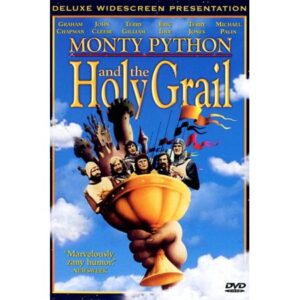Monty Python And The Holy Grail Illustrates Wage-And-Hour Law (Part I)
What does Holy Grail have to do with classification of employees as exempt or non-exempt?
 Monty Python and the Holy Grail is one of my favorite movies of all time. I lost count a long time ago of how many times I’ve watched it. I even went to a special screening of it a few years ago featuring a live Q&A with John Cleese afterward. All the comedy troupe’s films (and their show) are great, but Holy Grail stands above the rest for me.
Monty Python and the Holy Grail is one of my favorite movies of all time. I lost count a long time ago of how many times I’ve watched it. I even went to a special screening of it a few years ago featuring a live Q&A with John Cleese afterward. All the comedy troupe’s films (and their show) are great, but Holy Grail stands above the rest for me.
But what does Holy Grail have to do with employment law?
Exempt v. Non-Exempt Employees

Legal AI: 3 Steps Law Firms Should Take Now
A very important area of employment law that creates a lot of misunderstanding among people who aren’t full-time employment lawyers is the classification of employees as exempt or non-exempt. Most of the time, exempt employees can be paid a flat salary and are not entitled to overtime when they work over 40 hours in a workweek. Non-exempt employees are usually paid hourly and are entitled to time-and-a-half for all hours worked over 40 in a workweek.
A common misconception is that a company can simply pick one or the other. Tired of paying all that overtime? Just call the employees exempt, pay them a flat salary, and voila, no more overtime! Right?
Wrong.
The federal Fair Labor Standards Act and the U.S. Department of Labor’s regulations have very specific rules that govern when employees can be classified as exempt and not be entitled to overtime pay. There are a limited number of exempt classifications for employees. The most common are found in section 13(a)(1) of the FLSA which provides exemptions for employees working in executive, administrative, and professional roles. (There are other types of roles that may be exempt as well, but these are three of the most common.)
Sponsored

The Business Case For AI At Your Law Firm


Early Adopters Of Legal AI Gaining Competitive Edge In Marketplace

Is The Future Of Law Distributed? Lessons From The Tech Adoption Curve

Is The Future Of Law Distributed? Lessons From The Tech Adoption Curve
To qualify for one of the exemptions, an employee must meet two tests: (1) the salary test and (2) the duties test. The salary test is easy. The employee must be paid on a salary basis at not less than $455 per week (although that amount will be going up soon with updated regs from the U.S. Department of Labor). That’s it.
The duties test is more complicated. To qualify for one of the exemptions, the employees must perform certain job duties and have certain levels of responsibility within an organization. The U.S. Department of Labor has a detailed explanation here of each of the exemptions.
I’m going to use examples from Holy Grail to show how these exemptions work in this article and in parts two and three in the coming weeks.
The Executive Exemption
Let’s start with a relatively easy one.
Sponsored

Navigating Financial Success by Avoiding Common Pitfalls and Maximizing Firm Performance

Legal AI: 3 Steps Law Firms Should Take Now
To qualify for the executive exemption, the first prong of the test is that an employee’s primary duty must be managing the enterprise or managing a customarily recognized department or subdivision of the enterprise. The second prong requires that the employee also customarily and regularly direct the work of at least two or more other full-time employees or their equivalent.
Finally, the third prong is that the employee must have the authority to hire or fire other employees, or the employee’s suggestions and recommendations as to the hiring, firing, advancement, promotion, or any other change of status of other employees must be given particular weight. The employee must meet all three of these requirements to qualify for the executive exemption.
King Arthur easily meets all the requirements for the executive exemption. First, he manages the enterprise. After all, he is the one who came up with the idea for the Knights of the Round Table and he was the one who was assigned the quest for the Holy Grail by God himself (“A blessing, a blessing from the Lord!”). He is in charge of the other knights and they all follow his directives. Arthur therefore manages the enterprise and satisfies the first prong.
The other knights might meet this prong because, after joining with Arthur, they each go on to “manage” their own piece of the quest and their own adventures. For example, during Sir Lancelot’s quest, he (on his own) valiantly attempts the rescue of Prince Herbert. He was not directed by King Arthur to do this. One could argue then that each of the knights are in fact managing at least a subdivision of the enterprise by doing their own individual quests.
Turning to the second prong of the executive exemption, King Arthur also meets this part of the test because he directs the work of the other knights and his servants (e.g., Patsy). He thus regularly manages two or more subordinates.
The other knights also satisfy this prong because they each have their own band of servants and hangers-on they direct. (For example, Sir Robin’s Minstrels. Although it’s not clear how much actual control Sir Robin has over them.)
King Arthur also has the authority to hire and fire employees, and so he meets the third prong of the test. As the opening scene demonstrates, he and his faithful servant Patsy begin their adventures by traveling the land (on their horses) in search of knights to join Arthur at Camelot (although Arthur later dubs it “a silly place”). As he encounters and evaluates his eventual Knights of the Round Table, he alone has the authority to hire these other knights. He does not consult with anyone or need anyone’s permission.
But the other knights don’t seem to have that authority. At no point in the film do we see the other knights recruiting others to join their court at Camelot or otherwise “hiring” anyone else. Instead, they go off on their own adventures in the business of the enterprise (namely, seeking the Holy Grail) and sort of do their own thing. While they might have some say in the hiring or firing of the other knights or others, that’s not clear in the film. So the other knights probably don’t meet the final prong of the executive exemption and would either have to be classified as non-exempt or maybe meet one of the other exemptions.
King Arthur is thus probably the only one who meets the requirements of the executive exemption. And that is how it usually is in most organizations: Typically, only the highest-level folks qualify for that exemption.
In the upcoming parts of this article, I’ll illustrate the other exemptions and some other wage-and-hour issues.
 Evan Gibbs is an attorney at Troutman Sanders, where he primarily litigates employment cases and handles traditional labor matters. Connect with him on LinkedIn here, or e-mail him here. (The views expressed in this column are his own.)
Evan Gibbs is an attorney at Troutman Sanders, where he primarily litigates employment cases and handles traditional labor matters. Connect with him on LinkedIn here, or e-mail him here. (The views expressed in this column are his own.)







